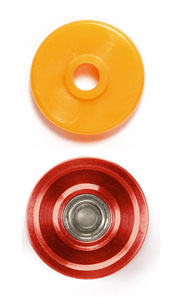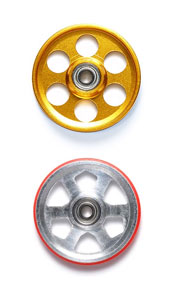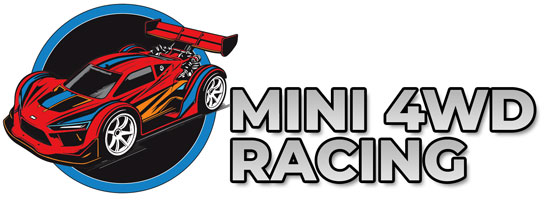Tamiya Mini 4WD Rollers
One of the critical components that influence the performance of a Tamiya Mini 4WD racers is the rollers. Rollers play a pivotal role in how the car navigates corners and maintains stability at high speeds. In this article, we check out the various aspects of Tamiya Mini 4WD rollers including their sizes, materials and types, to help enthusiasts optimize their cars for better handling and performance.
Roller Sizes and Their Effects
Rollers come in various sizes, typically ranging from 9mm to 19mm in diameter. The size of the rollers significantly impacts the car's handling characteristics:
 Small Rollers (9mm to 12mm): Smaller rollers are usually used in the front of the car and provide better grip and sharper turning capabilities, making them ideal for technical tracks with numerous curves and tight corners. However, they may not offer the best stability at high speeds.
Small Rollers (9mm to 12mm): Smaller rollers are usually used in the front of the car and provide better grip and sharper turning capabilities, making them ideal for technical tracks with numerous curves and tight corners. However, they may not offer the best stability at high speeds.
Medium Rollers (13mm to 16mm): These rollers are a balanced choice and can be used both in the front and rear. They offer a good compromise between grip and stability, making them versatile for a variety of track conditions.
Large Rollers (17mm to 19mm): Typically used in the rear, larger rollers enhance the car's stability, especially on straighter tracks. They help maintain speed and prevent the car from flipping over, although they may reduce turning sharpness.
Materials: Plastic vs. Aluminum Rollers
 The material of the rollers also affects the car's performance. The two primary materials used are plastic and aluminum:
The material of the rollers also affects the car's performance. The two primary materials used are plastic and aluminum:
Plastic Rollers: Plastic rollers are ideal for beginners due to their ease of use and availability. They provide decent handling and are less likely to cause damage to the car upon impact. However, they may wear out faster and offer less durability compared to metal rollers.
Plastic Rollers are allowed in all classes but must be used in the Box Stock and Basic classes.
Aluminum Rollers: Aluminum rollers are more durable and provide better stability, especially at high speeds. They are heavier than plastic rollers which can enhance the car's traction and stability but might slightly reduce acceleration. Aluminum rollers are also preferred because they come equipped with ball bearings instead of bushings.
Aluminum Rollers can only be used in the Tuned, BMax, Advanced and Open classes.
Ring vs Ringless Rollers
 Rollers also come in ring and ringless variants, each offering distinct advantages:
Rollers also come in ring and ringless variants, each offering distinct advantages:
Ringed Rollers: These rollers have an outer ring, usually made of a different material like rubber or plastic. Ringed rollers can reduce the likelihood of the car skidding or losing control on sharp turns.
• Rubber Ring: Rollers with a rubber ring have extra grip and are beneficial for maintaining contact with the track through sections like a crossover.
• Plastic Ring: Rollers with a plastic ring have reduced grip and can provide more speed over a rubber-ringed or even aluminum roller.
Ringless Rollers: These rollers lack the outer ring, presenting a smooth surface. They are preferred for high-speed tracks where minimizing friction is crucial. Ringless rollers reduce drag and can help achieve higher speeds but might sacrifice some grip and stability during turns.
Optimizing Roller Setup
Choosing the right combination of roller sizes, materials and types is essential for optimizing your Tamiya Mini 4WD car. Here are some tips for setting up your rollers:
Same Size Rollers Front/Back: This is a standard setting - Front and rear rollers with the same diameter. This makes your car run straight since rollers are parallel when they contact a wall. This also minimizes power loss.
Bigger Rollers in Front: Front roller diameter is bigger than the rear. Suitable for courses with many corners since this pushes your car towards the center of the lane when rollers contact a wall.
Smaller Rollers in Front: Rear roller diameter is bigger than the front. This makes your car run along with a wall, giving stability during cornering. This does, however, create a tiny bit of power loss.
